Best Mid Layers
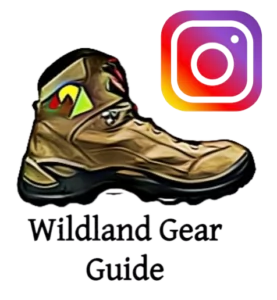 Don't forget to follow us on Instagram for the latest gear news!
Don't forget to follow us on Instagram for the latest gear news!
Don’t let the name fool you. There’s nothing middling or mediocre about the best mid layers when it comes to warmth. These layers are your heavy hitters when it comes to heat retention. The name “mid-layer” simply comes from this layer’s position nestled squarely between your cozy base layers (i.e., long underwear) and your weatherproof rain jacket. Fleece, down, and synthetic insulation are all fantastic options that offer tremendous warmth, and each one comes with its own strengths and weaknesses. But just how many fleece, down, and synthetic options are there? A lot! That’s why we’ve taken the stress out of choosing your next cozy layer by researching and testing the top mid-layers for hiking, and compiling our suggestions here for you to review.
Remember, packing sufficient insulation is essential for being prepared in the backcountry, and is 1 of the 10 essentials recommended by the National Park Service. In fact, all USA Hiking Tours from Utah camping tours to Yellowstone backpacking trips should include a good mid layer. So let’s take a look at the top buying considerations for this category, followed by our recommendations for the best mid layers currently on the market.
QUICK LIST OF RECOMMENDATIONS
- Best Down Mid Layer For Hiking – Patagonia Down Sweater – Men’s / Women’s
- Best Wool Mid Layer for Hiking – Ibex Indie Hoodie – Men’s / Women’s
- Best Mid Layer for Stylish and Effective Insulation – Cotopaxi Fuego Hooded Jacket – Men’s / Women’s
- Best Mid Layer for Budget-Minded Hikers – REI Co-op 650 Down Jacket – Men’s / Women’s
- Best Fleece Mid Layer – Patagonia R1 Full Zip Hoodie – Men’s / Women’s
Honorable Mentions
KEY CONSIDERATIONS
Fabric and Insulation
Two of the main factors you’ll be looking at when choosing the best mid layer are fabric and insulation. In some cases – such as with fleece jackets – the fabric is the insulation. However, all of our recommendations below are insulated jackets with an outer fabric and an inner insulating material.
The outer fabric will vary significantly, from simple polyester to more technical blends that provide greater stretch and durability. We’ve picked mid layers that have what we consider high-quality fabrics and insulation. Fleece, synthetic, and down insulation all function as excellent mid layers, so let’s go over the pros and cons of each of these three choices to help explain our decision-making process.
Fleece Considerations
Fleece has the potential to be an excellent fabric for outdoor adventure clothing and mid layers. Let’s take a closer look to see how.
Most fleece materials are affordable, insulating (when wet or dry), quick-drying, and durable. But these excellent characteristics are, sadly, balanced by the fact the fleece is not nearly as compressible as down and can also be noticeably heavier to achieve the same insulation. Therefore, fleece is often overlooked for down as many hikers don’t want a single layer to take up an excessive amount of space in their bag. But fleece’s durability and affordability are hard to beat, and it’s slowly making a comeback in the outdoors as more performance-based options emerge. A solid fleece garment can easily be the best mid layer for you if you’re hard on your clothing, often hike in wet conditions, or are looking for an accessible entry-level layer.
Fleece Pros:
- Warm when both dry and wet
- Quick-drying
- Durable
- Cost-effective
Fleece Cons:
- Heavy
- Not compressible
- Very bulky for hiking trips where space is at a premium
Down-Fill considerations
A down-fill jacket or sweater is an excellent choice for your mid layer. Down is durable (its insulating qualities last for years if well cared for), light, and packable. A good down jacket will add very little to your pack’s weight or bulk yet provide a dramatic level of warmth when needed.
The main drawbacks of down-filled garments are their cost (down is often quite expensive), lack of insulation when wet, slow drying, and possible ethical concerns with how the down is sourced (more on this below). Altogether, down has become the mid layer material of choice for almost any sport, not just hiking and backpacking, and you’ll see the majority of our recommendations follow this trend.
Down-Fill Pros:
- Very warm
- Compressible
- Exceptionally lightweight
- Long-lasting if cared for
Down-Fill Cons:
- Loses insulation capability when wet
- Higher cost
- Slow drying
- Possible ethical considerations (discussed next)
ETHICAL STANDARDS WITH DOWN
- Sourcing goose down can be a brutal affair, or it can be done humanely. It’s possible to search out manufacturers and brands that source down from traceable farms that verify the ethical treatment of their animals.
- The leading certification and best information source for ethical standards in the down industry is the Responsible Down Standard.
- All of our down-fill recommendations below source their down from farms that verify the ethical treatment of the animals.
Synthetic-Fill considerations
While synthetic fill mid layers can feel very similar to their cousins in the down category, they have several key differences. Synthetic fill is slightly heavier, less compressible, less durable and a little less insulating than down, but more insulating than fleece. Two major benefits of synthetic fill are its low cost compared to down and ability to insulate when wet (and dry quicker). All in all, synthetic-fill jackets make for excellent mid layers, and we have some listed below among our top picks.
Synthetic Pros:
- Insulates when wet
- Less expensive than down insulation
- More insulating capability than fleece
Synthetic Cons:
- Bulkier and heavier than down
- Not as long-lasting as down or fleece
- Not as insulating as down
Patagonia Down Sweater
Best Down Mid Layer for Hiking
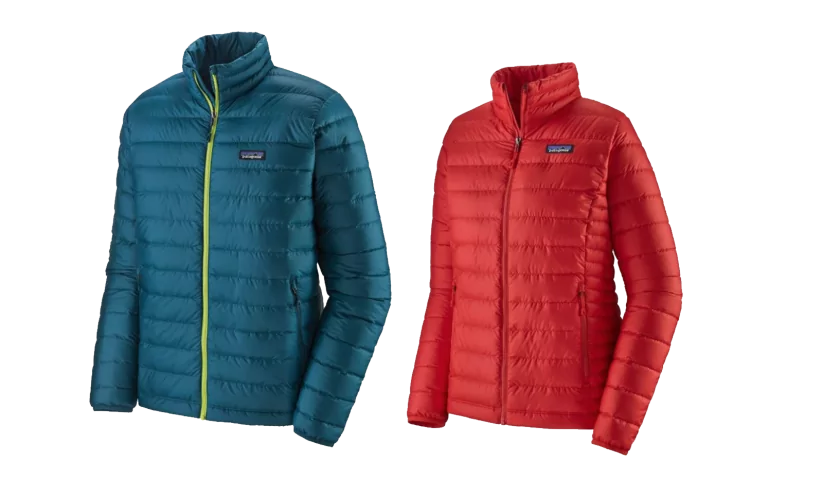 MSRP:
MSRP:
- Regular: $279.00
- Hooded: 329.00
- INSULATION: 800-fill traceable goose down
- HOOD: Yes (Hood-Specific Version)
- WEIGHT
- Men’s: 13 oz
- Women’s: 10.3 oz
- FABRIC: Recycled ripstop polyester
- PACKABILITY: Excellent
PROS: Very lightweight – Excellent packability – Warm – Sustainable production – Durable
CONS: Does not insulate when wet – Slow drying – High cost
LOOKING CLOSER: Patagonia’s Down Sweater is one of the most legendary mid layers in the outdoor adventure world. For many years, it’s been a top choice for hikers, backpackers, climbers, skiers, and others – and it’s not hard to see why. We have very high-quality down insulation, sourced to the highest ethical standards, along with a very compressible and robust design that makes it easy to take this layer anywhere.
With 800-fill power down, its warmth-to-weight/bulk ratio is nearly as good as it gets. The outer fabric, sourced from recycled materials, is ripstop, and we’ve found it to be one of the most durable. Down lasts nearly forever if well cared for, which further increases the durability. Like most items from Patagonia, this jacket has a relatively high cost but is easily one of the best mid layers on the market, and we also love that it comes with a hooded version for extra warmth.
View on REI.com
View on Backcountry.com
Ibex Indie Hoodie
Best Wool Mid Layer for Hiking
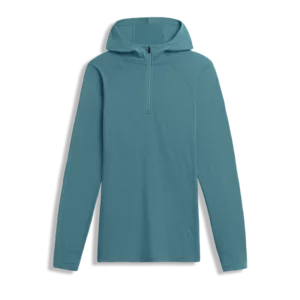 MSRP: $170.00
MSRP: $170.00- INSULATION: 100% Merino Wool
- HOOD: Yes – scuba hood
- WEIGHT
- Men’s: Not available
- Women’s: Not available
- FABRIC: 100% Merino Wool
- PACKABILITY: Good
PROS: Moisture wicking – Natural odor control – Quick drying – Insulates when wet – Effective in warm or cool environments
CONS: Small amount of pilling over time – Slightly scratchy feeling (dissipates after a few washes) – Not as insulating as down
LOOKING CLOSER: Merino wool has a long list of properties that make it ideal as a mid layer, and Ibex has woven these properties into the impressive Indie Hoodie. Backed by Ibex’s eco-conscience, ethical, and transparent business practices, the Indie Hoodie is a solid performer in the backcountry. The merino wool has superb moisture-wicking and temperature-regulating properties. This means that the Indie is perfect for both warm and cold conditions, and our testing found the overall design to be robust and durable – holding up to the rigors of backpack guiding.
For a complete report on this product, take a look at our Ibex Indie Hoodie review – courtesy of Wildland guide Liz Lucas.
View At IBEX.com
Cotopaxi Fuego Hooded Down Jacket
Best Mid Layer for stylish and effective insulation
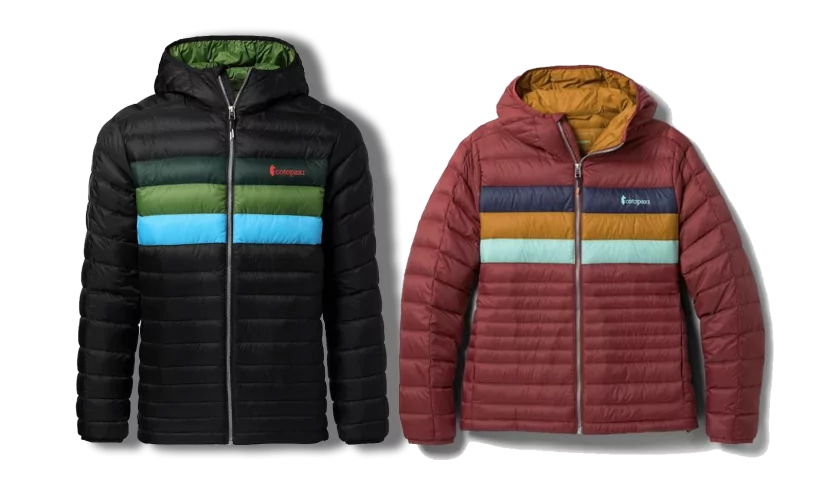 MSRP: $295.00
MSRP: $295.00- INSULATION: 800-fill-power goose down
- HOOD: Yes
- WEIGHT: 12-14 ounces
- FABRIC: 20-denier ripstop nylon
- PACKABILITY: Excellent
PROS: Water-resistant coating – Versatile – Lightweight – Great appearance
CONS: Expensive – Does not insulate when wet
LOOKING CLOSER: Cotopaxi’s Fuego Hooded Down Jacket is our top pick when it comes to great-looking mid layers. In addition to the beautiful color scheme, it’s also an extremely effective and well-designed jacket. With 800-fill-power down, it has nearly top-of-the-line insulation along with a treated outer material to enhance the jacket’s weather resistance. Apart from the Durable Water Repellent (DWR) finish, the outer fabric is also very durable and well constructed. Combine this information with the fact that down-fill insulation is inherently long-lasting if well cared for, and we have a beautifully crafted mid layer that will turn heads with its stylish design and easily earns its place among the best mid layers on the market. Like many down layers, however, keep in mind that this option comes with a high price tag, and the down insulation will lose its ability to keep you warm if it gets wet.
View on REI.com
View on Backcountry.com
REI Co-op 650 Down Jacket
Best Mid Layer for the Budget-Minded Hiker
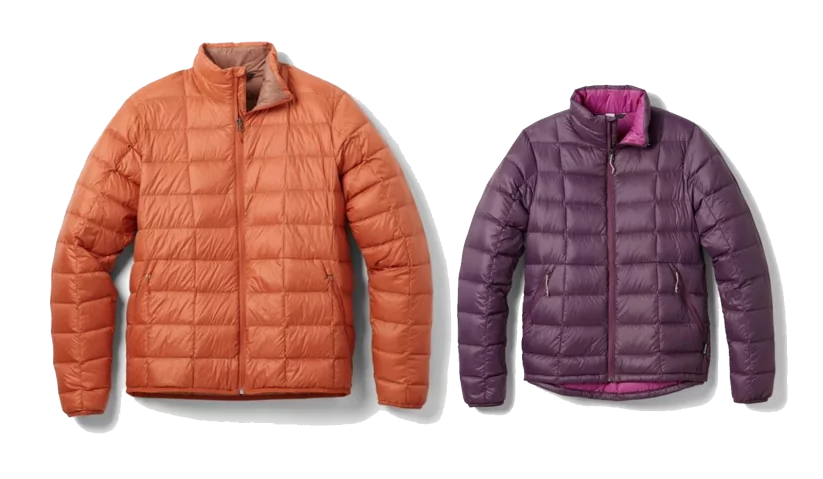 MSRP: $129.00
MSRP: $129.00- INSULATION: 650-fill-power down
- HOOD: No
- WEIGHT: 10.5 ounces
- FABRIC: Recycled ripstop
- PACKABILITY: Excellent
PROS: Affordable – Lightweight – Packable – Warm – Sustainable production
CONS: Does not insulate when wet – Slow drying – No hood – Lower quality down
LOOKING CLOSER: REI’s 650 Down Jacket 2.0 is an excellent mid layer for hiking and backpacking trips, particularly considering its very affordable price. 650-fill down is not the highest quality down on the market, but it’s still very good and will get the job done with good warmth retention combined with a very comfortable feel. This jacket can also pack down very small and adds only about 10 ounces of weight to your pack. It will last years or possibly even decades if well cared for, as down is durable and long-lasting. Bottom line: if you are ok with good – but not the very best – performance and budget is your larger priority, this jacket is the best mid layer for you.
View on REI.com
Patagonia R1 Fleece
Best Fleece Midlayer
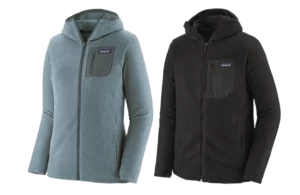
- MSRP: $179.00
- INSULATION: Recycled Polyester Fleece
- HOOD: Yes for Full-Zip Version
- WEIGHT
- Men’s: 12.9 oz.
- Women’s: 10.9 oz.
- PACKABILITY: Poor (compared to down)
PROS: Sustainable production – Very durable construction – Insulates when wet – Very Breathable
CONS: Doesn’t pack down very well – expensive for a fleece
STRAIGHT TALK: When it comes to performance fleeces designed exclusively for hard work, the R1 Air is hard to beat. The distinctive zig-zag pattern offers superb breathability and moisture-wicking properties, which are absolute gold for a hard day of hiking. But despite the excellent airflow, the R1 Air still retains ample heat to keep you cozy when the cool evenings approach. Now, this is a lightweight performance fleece and won’t provide the same level of warmth as a toasty down layer. However, this could be the best fleece mid-layer for you for cool evenings in the summer or all-day hiking in the chilly shoulder seasons (spring and fall).
View on REI.com
MEN’S Full-ZipWOMEN’S Full-Zip
View on Backcountry.com
MEN’S Full ZipWOMEN’S Full Zip

Patagonia Nano Puff Insulated Hoodie
Best Mid Layer for Mild temperatures
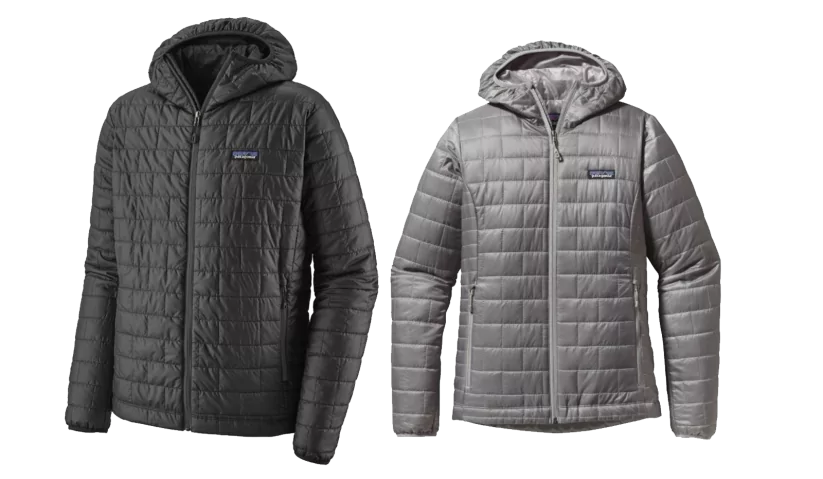 MSRP: $289.00
MSRP: $289.00- INSULATION: 60-g PrimaLoft Gold Insulation Eco polyester (55% post-consumer recycled content)
- HOOD: Yes
- WEIGHT: 11-13 ounces
- FABRIC: Recycled polyester with DWR (durable water repellent) finish
- PACKABILITY: Good
PROS: Sustainable production – insulates when wet – Water-resistant – Moderate warmth – Breathable
CONS: Expensive – Not for very cold environments
LOOKING CLOSER: Patagonia’s Nano Puff Insulated Hoodie is our top pick for people who naturally stay warm and want a versatile, moderately insulating layer or for folks adventuring in mild climates that won’t get too cold. This jacket is water-resistant and can be used as an outer layer in moderately poor weather, making it very versatile. The Nano Puff is also very breathable and packable, further adding to its appeal for hiking and backpacking. Like all Patagonia products, it’s manufactured with recycled and sustainably sourced materials. While it comes with a high price tag, the Patagonia Nano Puff is definitely one of the best mid layers for hikers who run warm or are adventuring in mild temperatures.
View on REI.com
View on Backcountry.com
Outdoor Research SuperStrand LT
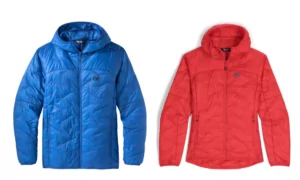 MSRP: $235.00
MSRP: $235.00- INSULATION: Synthetic Polyester Fibers
- HOOD: Yes
- WEIGHT
- Men’s: 10.9 oz.
- Women’s: 9.6 oz.
- PACKABILITY: Good
PROS: Surprisingly lightweight – Insulates when wet – Very effective warmth retention
CONS: Very thin shell material feels delicate
STRAIGHT TALK: Outdoor Research has been producing reliable layers for several years, and their SuperStrand has definitely become one of the best mid layers on the market. The synthetic polyester fibers provide excellent warmth, yet Outdoor Research has done a remarkable job keeping the jacket’s overall weight down and maximizing packability. This layer is also notably more affordable than most premium-level down options but still provides comparable warmth and protection. Keep in mind, however, that the excellent weight and packability are in part due to the very thin shell material that feels slightly fragile.
View on REI.com
View on Backcountry.com
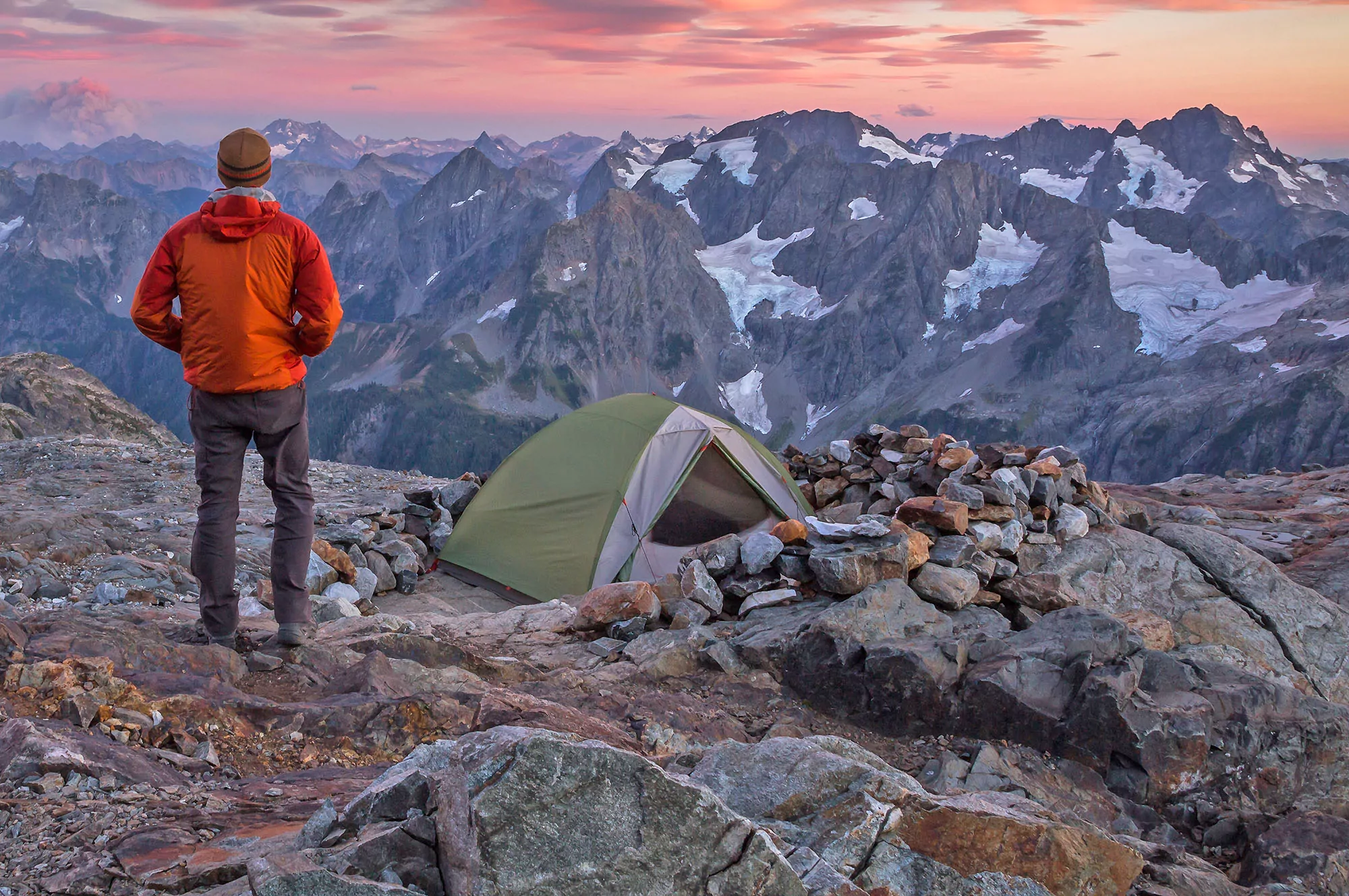
More Information About Mid Layers
Down Fill Power
When looking at down products, you will notice a number associated with the fill of the down – 400, 500, 650, 800, and so on. It’s helpful to understand this measurement when selecting your mid layer or other down-filled items.
“Fill power” is the most common factor used to measure down quality in jackets and sleeping bags. It denotes the amount of loft of the goose or duck-down fibers. “Maximum loft” is measured when the down fibers are fully and naturally expanded, while the fill power is how many cubic inches an ounce of down expands to at its maximum loft. A rating of 800, for instance, means that one ounce of down expands to 800 cubic inches.
Fill power can vary from below 300 to a maximum of 900. Many common down jackets and sleeping bags feature around 500 fill down. However, these lower ratings indicate poor quality down that was likely sourced from immature birds. Instead, we recommend looking for down ratings of at least 600 to ensure you’re getting a high-quality product that will keep you warm.
Why Trust Us?
Choosing the right outdoor gear and apparel can be difficult. But at Wildland Trekking, we live and work with hiking gear every single day. It’s an integral part of what we do, and we understand better than anyone how important it is to have the right equipment. In addition to our vast knowledge of backpacking gear, we also offer:
- Independence – our recommendations are not influenced by partnerships or sponsorships with outdoor gear and apparel manufacturers.
- Experience – as one of America’s top guide companies, we take 8,000-10,000 people on hiking and backpacking tours annually. Since our inception in 2005, we have guided more than 75,000 people into the wilderness.
- Cutting Edge Knowledge – we regularly attend trade shows and pay close attention to the leading edge of new developments.
- Up To Date Recommendations – we update our recommendations regularly as new products are developed and released.
- Dedication to our Readers – we know that the gear we select as our top picks will end up in the field with our readers, and we take that responsibility very seriously. We view our readers as guests on our guided trips, just without the guides. We are committed to helping you be as well-outfitted and prepared as possible for your adventures.
*Disclosure: Some of the links above are affiliate links. At no cost to you, we earn a commission on any products purchased through these links. Any proceeds go to supporting our blog and operations. These affiliate links do not influence the products that we include in our gear round-ups. We only recommend products that we 100% support and that we have used in the field.

More Gear Recommendations
Check out our Wildland Gear Guide for more recommendations about hiking, trekking, camping and outdoor gear. We are always adding new products to help our guests and readers make the best choices to outfit their adventures.
- Packing List Quick Links for Wildland Guests
- Wildland Packing List Video
- Best Low Top Hiking Shoes
- Best Boots for Backpacking Trips
- Best Rain Jackets
- Best Rain Pants
- Best Long Underwear
- Best Tents for Backpacking Trips
- Best Tents for Car Camping Trips
- Best Backpacking Backpacks
- Best Daypacks
- Best Trekking Poles
- Best Sleeping Bags
- Best Headlamps for Hiking
- Best Backpacking Sleeping Pads
- Best Backpacking Stoves
- Best Backpacking Water Filters
- Best Hiking Socks
- Best Backpacking Cookware
- Best Hiking Shirts and Tops
- Best Hiking Pants
- Best Camp Shoes
- Best Hiking Shorts
- Best Gaiters
- Best Sun Hats
- Best Sun Hoodies
- Best Hydration Bladders
- Best Duffel Bags
- Best Camp Towels




